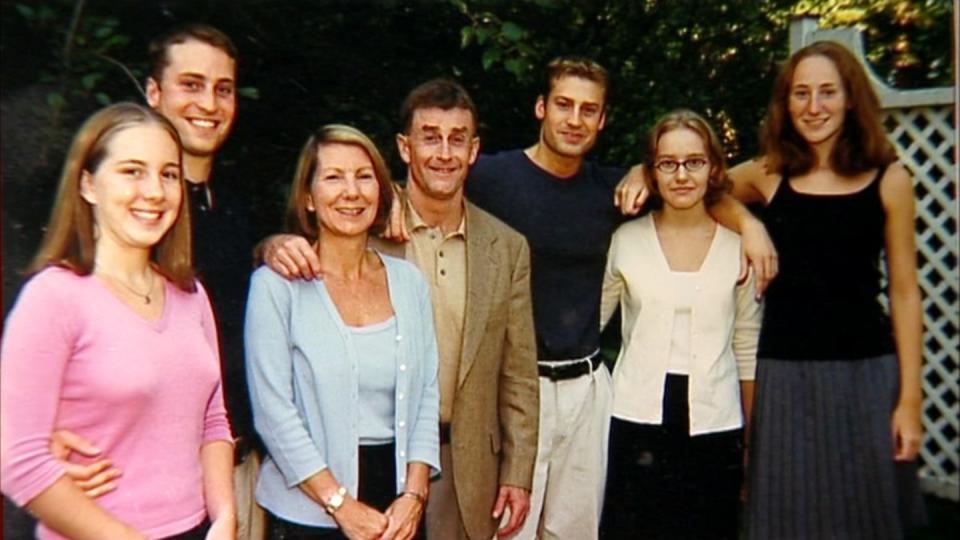There's a Reason Producers Keep Adapting 'The Staircase'

"Hearst Magazines and Yahoo may earn commission or revenue on some items through the links below."
In 2001, Kathleen Peterson was found dead at the bottom of the stairs in the North Carolina home she shared with her husband, the novelist Michael Peterson.
"My wife had an accident," Peterson says on the 911 call. "She's still breathing. She fell down the stairs."
Shortly after, Peterson was charged with first-degree murder. The trial(s!) that followed was full of twists and kooky theories—blaming the death on everything from an owl attack to connecting it to a second slaying similar in nature. The bizarre case has been the subject of countless true crime podcasts, a Netflix docuseries, and has now been adapted by HBO Max into a new drama miniseries starring Colin Firth and Toni Collette.
Here's what to know about Peterson, his family, and his murder trial.
Peterson's family friend was also found dead at the bottom of a staircase
Before Peterson met Kathleen in 1986, he lived in Germany with his first wife Patricia Peterson, an elementary school teacher at an American military base there, according to People. The couple had two sons, Clayton and Todd.
While overseas, Patricia and Peterson befriended Elizabeth Ratliff, a mother of two young girls whose husband was killed while on a military mission. But one morning in November 1985, their dear friend was found dead at the bottom of a flight of stairs. The evening before she died, Peterson had been at her house, helping put her daughters, Margaret and Martha, to bed, according to NBC.
Ratliff was originally thought to have died from a fall down the staircase—until, of course, Kathleen Peterson was discovered dead in a very similar manner 15 years later. When Ratliff's sister, Margaret Blair, heard of Kathleen's death, she phoned the detective working on the case. "I said, 'Are you aware that the same thing happened to Margaret and Martha’s mother and Michael Peterson was the last one to be with her?'" she told NBC.
Ratliff's death was later re-examined and ruled a "homicide," although jurors in Kathleen's case say they dismissed her death altogether in their decision-making process, according to the outlet.

A "Happy" Life in Durham
After Ratliff died, the Peterson family adopted Margaret and Martha and moved back to the U.S.
When Peterson and Patricia's marriage began falling apart in the mid-'80s, the girls were the ones responsible for introducing Peterson to his next wife, Kathleen. The sisters were playmates with her daughter, Caitlin, who lived down the street in Durham, North Carolina. In 1987, the family moved in together, according to NBC.
"They all sat me down and said: 'How would you like it if Martha and Margaret come live with you?' And I immediately thought—'a permanent sleepover!'" Caitlin told NBC.
Peterson, a former newspaper columnist, penned several novels, including the popular 1990s WWII-era book A Time of War, which garnered interest from a Hollywood studio. According to NBC, he’d gotten “more than a half million dollar advance from his publisher" for one of his books.
He and Kathleen, a telecommunications company executive, raised the kids in a sprawling home, reports ABC News. According to the outlet, Peterson said in 2006, "We lived together for 14 years, and we were happy every one of those years."
His wife was found dead in their home
Peterson’s big "happy" family was torn apart on Dec. 9, 2001, when he called 911, claiming to have discovered Kathleen alive, but unconscious, at the bottom of the staircase in their home.
Earlier in the evening, Peterson says the couple had eaten dinner, watched the movie America’s Sweethearts, and sat out by the pool. He claims Kathleen went to bed, while he stayed outside to smoke a pipe. The defense claimed that Kathleen, after drinking some wine and taking valium, tried to walk up the poorly lit stairwell, fell, and bled to death.
But when Detective Art Holland of the Durham police arrived at their home, the scene immediately struck him as suspicious: Kathleen was "splayed out on the floor, her head resting on the landing of a back staircase," according to NBC. Police also saw a bottle of wine and two glasses on the kitchen counter "neatly arrayed—implying, perhaps, the couple had passed a relaxing evening at home sipping wine together," reports the outlet. Except Kathleen's fingerprints weren't on either glass. In fact, a medical examiner later determined that her blood alcohol content was so low she would have passed a breathalyzer test if she'd taken one.
The ME determined that Kathleen had been bludgeoned to death and suffered seven deep lacerations on the scalp. The blood around the victim was mostly dry, meaning that she'd been lying at the bottom of the stairs for a long time. Former District Attorney Judge Jim Hardin told NBC she was there for around two hours.
The state's blood-spatter expert claimed that blood droplets around the stairwell were made by the striking of a weapon, according to the outlet.
The secret prostitute
Not long after Kathleen's body was found, Peterson, the prime suspect, was arrested and charged with first-degree murder. His trial began in July 2003.
In court, the state argued that his motive, in part, was connected to his sexuality. According to NBC, the prosecutor believed Kathleen had found 2,000 images of naked men on her husband's computer, plus an email exchange with a 26-year-old male escort who first contacted him four-months before the murder and whom Peterson was planning to meet. The prosecutor theorized Kathleen stumbled across the photos and emails, prompting a physical—and ultimately deadly—altercation between husband and wife.
Peterson was convicted of first-degree murder
On October 10, 2003, the jury found Peterson guilty of the murder of his wife. He was sentenced to life in prison without benefit of parole. Peterson maintained his innocence, reportedly saying: "I didn't do anything. I'm innocent. I did not believe until the jury clerk read the sentence that I would be convicted."

The owl theory
In 2009, an attorney brought to light a new theory citing compelling evidence to prove that Peterson was, in fact, not responsible for Kathleen’s death. Instead, he claimed an owl was to blame. According to The National Audubon Society, the "Owl Theory" posits that a Barred Owl—a common species in Durham—got entangled in Kathleen's hair, causing serious injuries, like the removal of part of her scalp, and caused her to fall to her death down the stairs. The society says Kathleen's "autopsy revealed seven lacerations, including very deep ones in the back of her scalp, and pine needles stuck to one of her hands, which both held clumps of her own hair." Plus, the strands in the victim’s left hand contained three small feathers.
"When you look at her injuries, they do appear consistent with being made by an owl’s talons," Peterson’s defense attorney Mary Jude Darrow told Audubon. "But I would hate to risk my client’s life or future on that argument."
According to WRAL, attorney Lawrence Pollard filed a new motion in Superior Court in 2009 that stated: "Thus, it is new and compelling evidence, and probably the single most important piece of evidence found so far in this case, because it connects the attack by a bird with the victim, and it is held in the victim's hand." No motion for a new trial was filed.
Peterson walks away, after discredited testimony
In 2011, a judge vacated the verdict and ordered a new trial after finding that a blood spatter analyst gave false and misleading testimony at Peterson's first trial, reports ABC. According to local media reports, Tim Palmbach of the Department of Forensic Science at the University of New Haven testified that the analyst "focused on only some of the blood droplets in the area and didn't disclose to jurors that there was other blood at the scene that didn't fit his findings. Also, many of [the analyst]'s tests appeared to be used to confirm a theory rather than sort through the evidence for the most likely scenario."
The ensuing legal saga continued all the way until February 2017, when Peterson reportedly entered an Alford plea to voluntary manslaughter in his wife’s murder and was released from custody. An Alford plea allows a defendant to maintain innocence while still acknowledging that the prosecution has enough evidence to convict. Prosecutors said they hoped the plea brought "a measure of justice" to Kathleen’s family.
His plea, although technically guilty, did not officially solve the mystery of Kathleen's death. "The words 'Alford plea' are meaningless. Alford smalford. It means nothing. Guilt!" Kathleen's sister, Candace Zamperini, allegedly yelled at Peterson during the trial. "You brutally took the life of a woman who provided for you, guarded your children, she loved you!"
Today, Peterson is 78 and remains a free man. He has published two books on his case since his release: Behind the Staircase and Beyond the Staircase. All of his profits were donated to charity. Peterson also dated Sophie Brunet, an editor of Jean-Xavier de Lestrade's award-winning documentary series on his case, from 2011 until 2017. Peterson now lives in Durham, "in a ground floor apartment with no stairs–that was really important accommodation," his lawyer David Rudolf said in 2019.
You Might Also Like

